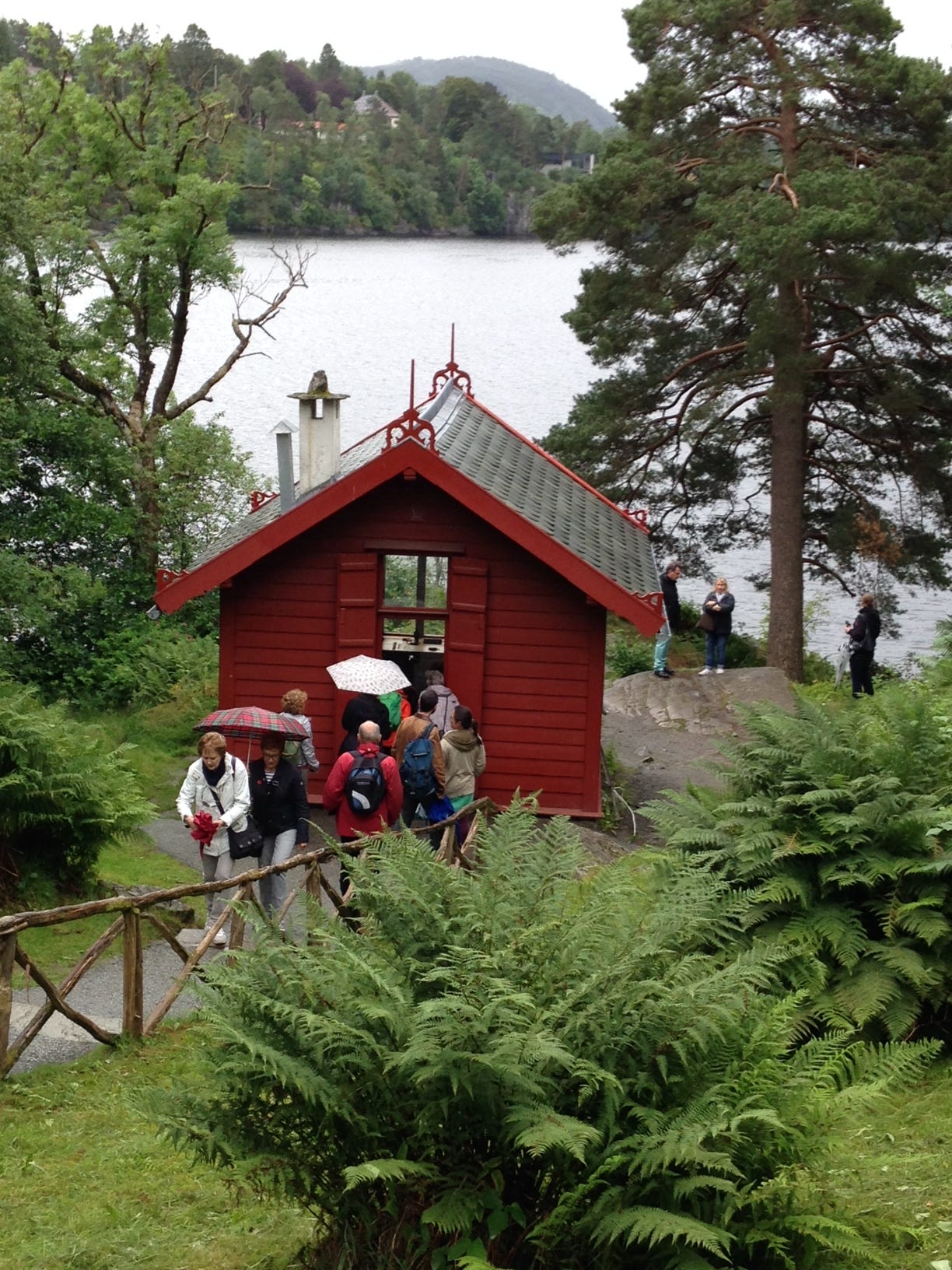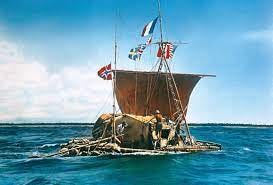Note: I was away all weekend to attend my son’s college graduation, so I didn’t have much time to write. I’m lightly revising and republishing an article I wrote for The Bridge, a magazine for expat women in Prague, about five years ago. The Happy Wanderer will be back next week with a brand-new article.
We Norwegian-Americans like to tell a joke: How can you tell if a Norwegian is an extrovert? When he’s talking to you, he stares at your shoes. But in 2016, when my family and I traveled through Norway, we discovered that this joke did a disservice to the people we met. Often our best experiences come when someone local shares something they’re passionate about. It doesn’t even matter whether we’re interested in the topic—what matters is the enthusiasm of the person who brings us into their world. My family and I were lucky to have thought-provoking encounters with Norwegians who taught us about music, traditional cider-making, human rights, and adventure.
Christian, the Pianist Just outside Bergen, on a hill overlooking a fjord, sits Troldhaugen (Troll Mountain), the home of composer Edvard Grieg. The estate, a scene of rocky, green beauty, features Grieg’s home, a concert hall nestled under a roof of thick sod (for insulation), and the little red waterside cottage where Grieg composed most of his work.
Our tour of the estate included a concert of Grieg’s piano music. The pianist, Christian, did not use Grieg's original piano—Grieg was only 150cm (4’11”) tall because of damage to his spine from tuberculosis, and so he had to have a piano with short legs specially built for him. Disarmingly humble, Grieg once said, “The music of Bach, Beethoven, and Brahms is like a temple or a cathedral, while mine is like a comfortable home.” Christian described the selections he played from Lyric Pieces as “beautiful, but the beauty has a little chill. It’s like Norwegians, who think ‘We like you, but we might not tell you that.’” During the concert I was struck by how concrete the pieces were: each evoked the subject of the piece in sound, whether it was a butterfly, a little troll, or a lullaby. Christian ended his concert with a show stopper—“Fra karnevalet” (“From the Carnival”)—a theme and variations that starts delicately and playfully and builds to a virtuosic ending. The performance prompted a standing ovation. Ever bashful, Christian told us he was “almost embarrassed to play it.” I couldn’t find a video of Christian playing it, but below you can enjoy the interpretation of the brilliant Russian pianist Mikhail Pletnev:
The beauty, playfulness, and modesty of Grieg’s music suits the Norwegian character perfectly.
Age, the Cider-Maker Halfway up a mountain in the tiny fjord town of Balestrand, amid over a hundred species of apple tree, you will find Ciderhuset, where the Eitungjerde family is bringing back the old methods of making cider. Our tour was filled with fascinating facts: Did you know that there are over 7500 different kinds of apples? Or that there are special cider apples that have high tannins, just like wine grapes? Or that cider has been produced in Norway since, allegedly, the time of the gods—and the gods got to drink a special kind of extra-strong distilled cider called björr?

But even better than the facts were the stories Age (pronounced AH-geh) told. For example, once upon a time, a troll abducted a god’s daughter, and to rescue his daughter the god kept offering the troll cider, so he would stay up all night drinking—the god knew that the troll would turn to stone at the first ray of the sun. It must have been delicious cider to distract the troll from the danger! Our tour ended in the cask cellar, where Age sings to the cider every evening so that it rests well. He had us close our eyes while he chanted the Salve Regina in a pure tenor.
It was a transcendent experience, and we emerged from the cellar spiritually refreshed—and ready to refresh our bodies with some cider.
Lars, the Witness Our visit to Oslo coincided with the fifth anniversary of the mass murder of 77 people by Anders Breivik, an ultra-right-wing Norwegian terrorist, who set off bombs in central Oslo, killing 8 adults, and then murdered 69 teenagers and young adults at a camp for young leaders. Some of his victims were only 14. Our hotel was near the bombing site, so I went there to honor the victims. The site was marked by two wreaths, and while I was there a steady procession of visitors came through. People knelt at the memorial, hugged each other, and left flowers.
One of the mourners was Lars, an international expert on right-wing hate groups and terrorism, who served as an expert witness at Breivik’s trial. Surprisingly, he testified for the defense. Breivik had been declared insane, but he insisted on his sanity because he thought his ideas were correct and didn’t want them to be discredited with an insanity plea. Lars agreed that Breivik was legally sane, although evil; as Lars said on the Humans of Oslo Facebook page, “Despite seeing the fear in their eyes, and children begging for their lives, [Breivik] shot them anyway—one by one. … That was pure evil! He had opened the gates of hell and showed us what evil looks like. … There wasn’t a single journalist without tears in their eyes that day in the courtroom.” But this terrorist’s evil didn't cause the Norwegians to abandon the rule of law or their opposition to the death penalty. And on that sad July day five years later, people came together to honor the dead and to renew the promise to fight hatred.
Helmuth, the Adventurer’s Friend My parents visited the Kon-Tiki Museum in Oslo and got into an amusing conversation with an elderly man, Helmuth, who was friends with Herman Watzinger, the first person to join Thor Heyerdahl on his quixotic mission to prove that Peruvians could have settled Easter Island. To “prove” this point, Heyerdahl and his crew sailed across the Pacific on a little balsa raft using only tools and items available in pre-Columbian times.
Helmuth told my parents that Watzinger was a newlywed when he met Heyerdahl in a New York bar and heard about his quest. In Helmuth’s words, Watzinger “came home at 6am and started packing. His wife said, ‘What are you doing?’ and Herman announced, ‘I’m going to Peru!’ An hour later, a cab arrived and took him away from his job and his new wife.” Amazingly, his wife supported his decision.
The Kon-Tiki did make it safely across the Pacific, but anthropologists now agree that Heyerdahl was wrong, and Easter Island was in fact settled by Polynesians from the west. Nonetheless, Helmuth’s enthusiasm in telling his friend’s story reminds us that we armchair travellers should feel grateful that our spouses don’t run off on harebrained quests at a moment’s notice—and that it is fine for us, like Helmuth, to experience the inspiration and wonder of Heyerdahl’s journey vicariously.
Looking back on our various encounters with these passionate Norwegians, I am struck by how similar their preoccupations are. All four men use their talents and enthusiasm to bring us beauty, light, and knowledge. How do we make a better world? Perhaps all we need to do, like Grieg, is to construct a “comfortable home” and share it with others.
How about you, readers? Have you encountered a passionate and fascinating person on your travels? What did s/he teach you? Please share your stories in the comments!
The Tidbit
In this glorious song, the singer recounts a dream of a beautiful women, a dream that he discovers to his joy is real. The song begins in a hushed whisper and in two short minutes crescendos to ecstasy. The Swedish mezzo-soprano Anna Sofie von Otter sings the heck out of it. Enjoy!






Ahhh, the cidre! Missing the Citre from Bretagne, good and cheap! (and maybe dangerously able to create alcoholism!)